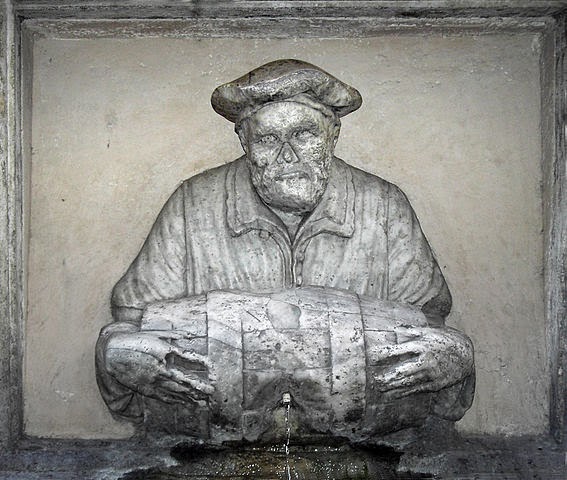 |
| Rome, 1572 |
It's threes all the way: In Part 3 of this three-part post on the Talking Statues of Rome, we will talk about three statues -- Abate Luigi, Il Facchino, and Il Babuino. For the background to this post, see the first post here and the second post here, or if you're in a hurry, make do with
The Short Recap:
In Renaissance Rome, poetry was a weapon. Free speech was not exactly a commonly-held value in those days – at least not by the people in charge – but the Roman people had plenty on their minds, and it tended to come out in the form of scurrilous, anonymous verse
Around the beginning of the 16th century, these entertaining but not-very-polite poems started appearing on a statue. In time, this first “talking statue” was joined by five others in various parts of town. Together, they became known as the “Congregation of Wits.” The messages were posted in the dead of night, and next morning people would cluster around to read them.
For all those hundreds of years, the people in charge have wished they could silence the talking statues, but at least some of the statues are still finding ways to “speak,” and their barbs have been felt by leaders as recent as Berlusconi and beyond.
Abate Luigi
He's a tall, imposing, handsome kind of guy, and he used to be no less than an emperor of Rome (though since he was wearing a different head at the time, nobody seems to know which emperor).
Now he's known as Abate Luigi (Abbot Luigi), and he hangs out near the Basilica di Sant'Andrea delle Valle. Centuries ago, he used to get involved occasionally in three-way conversations with Pasquino and Marforio (see previous two posts).
His plinth bears a plaque that says:
I was a citizen of ancient Rome. Now I am known as Abbot Luigi. Together with Marforio and Pasquino, I achieved eternal fame for civil satire. I have endured insults, disgrace and interment, but here my new life is finally secure.
This habit of losing his head, though, was not a one-time occurrence. Some say that the one he's wearing now is a concrete cast of a previous version. One writer observes that even though the head keeps disappearing, "it finds its way back." It, or another that will do just as well.
Il Facchino
Il Facchino ("the porter") should perhaps have been known instead as L'Aquaiolo (the water-seller), as the latter is the profession he represents. He stands patiently, dribbling water from his cask into the fountain he tops, on Via Lata.
Il Facchino is the only one of the six talking statues who was created in the Renaissance, rather than in classical times. It must have been before Pope Sixtus V (there's that name I love again!) started putting the ancient aqueducts back into service, in the days when water sellers roamed the streets bringing water to people's homes.
Il Babuino
I've saved my favorite for last. Il Babuino ("the baboon") guards his fountain on the street named for him: Via del Babuino. In the statues' heyday, this area was relatively unpoliced; thus, people could affix their most outrageous comments to the Baboon, safe from the authorities.
Il Babuino is probably a statue of a silenus, companion to Dionysus, usually represented as an old man with the legs and ears of a horse. I've seen him described as a "superb representation of a lecherous drunkard on the prowl." The Roman people, however, were apparently less impressed; they nicknamed him "The Baboon," and it stuck.
His turf is what used to be the Strangers' Quarter. A large community of foreigners lived there, and they used him to lampoon members of the Roman community - perhaps even the ones who were posting their own pasquinades on the other five statues.
In one of the recent crackdowns on the statues (Gianni Alemanno, recent mayor of Rome, was not a fan, for example), the powers-that-be hit upon the idea of painting the Baboon's backdrop with graffiti-proof paint, as you see it above, and here at a greater distance:
 |
| Il Babuino in his pristine environment |
But it was not always thus. Look at him here, in all his former glory:
Talking statues today
They're not the daily entertainment they used to be, back in the day, but once in a while a political comment still turns up on one of the statues. Most often it seems to be Pasquino. And when Alemanno cracked down on posting things directly on Pasquino, most of the posts that appeared on the board over to the side were digs at Alemanno for that new policy.
But whatever the Gang of Six was or wasn't doing in recent years, the spirit behind them lives on. One night during the period when Berlusconi's lurid private life was under legal investigation and public scrutiny, a group calling itself Nessun Dorma ("None shall sleep" - also the name of an aria from Puccini's Turandot) posted messages overnight on no fewer than 150 statues throughout Rome, with messages such as "Italy is not a brothel," and "The body of Italy is not for sale."
And that concludes my brief series on Rome's talking statues. I intend to visit them all next spring, take my own photos, and see for myself if any of them still have anything to say.
Images in this post are in the public domain, with the exception of the photo of Il Babuino with graffiti, which is licensed to Jerzystrzelecki via the Creative Commons Attribution 3.0 Unported license, Wikimedia Commons.



.jpg)


_-_n._0021_-_Roma_-_Arco_di_Settimio_Severo.jpg)























